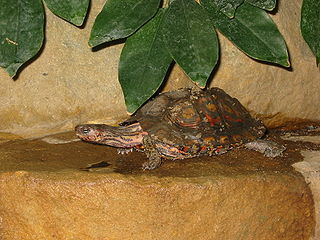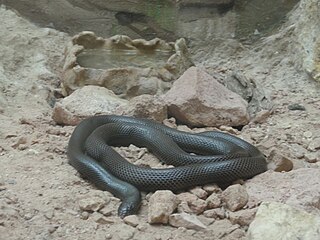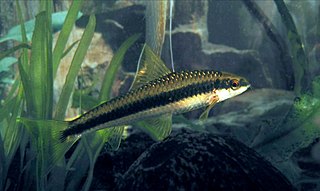
The Cyprinidae are the family of freshwater fish, collectively called cyprinids, that includes the carps, the true minnows, and their relatives. Also commonly called the "carp family", or "minnow family", Cyprinidae is the largest and most diverse fish family and the largest vertebrate animal family in general, with about 3,000 species of which only 1,270 remain extant, divided into about 370 genera. They range from about 12 mm to the 3-m Catlocarpio siamensis. The family belongs to the ostariophysian order Cypriniformes, of whose genera and species the cyprinids make up more than two-thirds. The family name is derived from the Ancient Greek kyprînos.

The Anatidae are the biological family of water birds that includes ducks, geese, and swans. The family has a cosmopolitan distribution, occurring on all the world's continents. These birds are adapted for swimming, floating on the water surface, and in some cases diving in at least shallow water. The family contains around 174 species in 43 genera.

The Old World flycatchers are a large family, the Muscicapidae, of small passerine birds mostly restricted to the Old World. These are mainly small arboreal insectivores, many of which, as the name implies, take their prey on the wing. The family includes 324 species and is divided into 51 genera.

Colubridae is a family of snakes. With 249 genera, it is the largest snake family. The earliest species of the family date back to the Oligocene epoch. Colubrid snakes are found on every continent except Antarctica.

The Noctuidae, commonly known as owlet moths, cutworms or armyworms, are the most controversial family in the superfamily Noctuoidea because many of the clades are constantly changing, along with the other families of the Noctuoidea. It was considered the largest family in Lepidoptera for a long time, but after regrouping Lymantriinae, Catocalinae and Calpinae within the family Erebidae, the latter holds this title now. Currently, Noctuidae is the second largest family in Noctuoidea, with about 1,089 genera and 11,772 species. However, this classification is still contingent, as more changes continue to appear between Noctuidae and Erebidae.

The Geoemydidae are one of the largest and most diverse families in the order Testudines (turtles), with about 70 species. The family includes the Eurasian pond and river turtles and Neotropical wood turtles.

The Atractaspidinae are a subfamily of snakes found in Africa and the Middle East, commonly called mole vipers, stiletto snakes, or burrowing asps. Currently, 12 genera are recognized.

Myrmeciinae is a subfamily of the Formicidae, ants once found worldwide but now restricted to Australia and New Caledonia. This subfamily is one of several ant subfamilies which possess gamergates, female worker ants which are able to mate and reproduce, thus sustaining the colony after the loss of the queen. The Myrmeciinae subfamily was formerly composed of only one genus, Myrmecia, but the subfamily was redescribed by Ward & Brady in 2003 to include two tribes and four genera: An additional three genera, one form genus, and 9 species were described in 2006 from the Early Eocene of Denmark, Canada, and Washington.

The Cricetidae are a family of rodents in the large and complex superfamily Muroidea. It includes true hamsters, voles, lemmings, and New World rats and mice. At almost 608 species, it is the second-largest family of mammals, and has members throughout the Americas, Europe and Asia.

The Drepanidae is a family of moths with about 660 species described worldwide. They are generally divided in three subfamilies which share the same type of hearing organ. Thyatirinae, previously often placed in their own family, bear a superficial resemblance to Noctuidae. Many species in the Drepanid family have a distinctively hook-shaped apex to the forewing, leading to their common name of hook-tips.

Blechnaceae is a family of ferns in the order Polypodiales, with a cosmopolitan distribution. Its status as a family and the number of genera included have both varied considerably. In the Pteridophyte Phylogeny Group classification of 2016, the family has 24 genera, and excludes genera placed in the separate family Onocleaceae. The family is divided into three subfamilies, including Blechnoideae s.s. Alternatively, the entire family may be treated as the subfamily Blechnoideae s.l. of a very broadly defined family Aspleniaceae, and include genera others place in Onocleaceae.

Noctuoidea is the superfamily of noctuid or "owlet" moths, and has more than 70,000 described species, the largest number of for any Lepidopteran superfamily. Its classification has not yet reached a satisfactory or stable state. Since the end of the 20th century, increasing availability of molecular phylogenetic data for this hugely successful radiation has led to several competing proposals for a taxonomic arrangement that correctly represents the relationships between the major lineages.

Polecat is a common name for mammals in the order Carnivora and subfamilies Ictonychinae and Mustelinae. Polecats do not form a single taxonomic rank ; the name is applied to several species with broad similarities to European polecats, the only polecat species native to the British Isles.

Ochodaeidae, also known as the sand-loving scarab beetles, is a small family of scarabaeiform beetles occurring in many parts of the world.

Kinosternoidea is a superfamily of aquatic turtles, which includes two families: Dermatemydidae, and Kinosternidae.

Eupterotidae is a family of insects in the order Lepidoptera with more than 300 described species.

Ennominae is the largest subfamily of the geometer moth family (Geometridae) with some 9,700 described species in 1,100 genera. They are usually a fairly small moths, though some grow to be considerably large. This subfamily has a global distribution. It includes some species that are notorious defoliating pests. The subfamily was first described by Philogène Auguste Joseph Duponchel in 1845.

Labeoninae is a doubtfully distinct subfamily of ray-finned fishes in the family Cyprinidae of order Cypriniformes. They inhabit fresh water and the largest species richness is in the region around southern China, but there are also species elsewhere in Asia, and some members of Garra and Labeo are from Africa. They are a generally very apomorphic group, perhaps the most "advanced" of the Cyprinidae. A common name for these fishes is labeonins or labeoins.

Lepidoperca is a small genus of fish belonging to the Anthiinae subfamily. It includes ten species.

Gobioninae is a monophyletic subfamily of Eurasian cyprinid fishes. A species-rich subfamily, it is divided into five tribes: Gobionini, Pseudogobionini, Hemibarbini, Coreiini, and Sarcocheilichthyini.



















